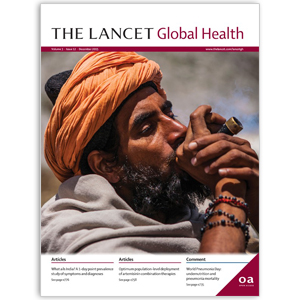
Background
Every year, 2·9 million newborn babies die worldwide. A meta-analysis of four cluster-randomised controlled trials estimated that home visits by trained community members in programme settings in Ghana and south Asia reduced neonatal mortality by 12% (95% CI 5–18). We aimed to estimate the costs and cost-effectiveness of newborn home visits in a programme setting.
Methods
We prospectively collected detailed cost data alongside the Newhints trial, which tested the effect of a home-visits intervention in seven districts in rural Ghana and showed a reduction of 8% (95% CI −12 to 25%) in neonatal mortality. The intervention consisted of a package of home visits to pregnant women and their babies in the first week of life by community-based surveillance volunteers. We calculated incremental cost-effectiveness ratios (ICERs) with Monte Carlo simulation and one-way sensitivity analyses and characterised uncertainty with cost-effectiveness planes and cost-effectiveness acceptability curves. We then modelled the potential cost-effectiveness for baseline neonatal mortality rates of 20–60 deaths per 1000 livebirths with use of a meta-analysis of effectiveness estimates.
Findings
In the 49 zones randomly allocated to receive the Newhints intervention, a mean of 407 (SD 18) community-based surveillance volunteers undertook home visits for 7848 pregnant women who gave birth to 7786 live babies in 2009. Annual economic cost of implementation was US$203?998, or $0·53 per person. In the base-case analysis, the Newhints intervention cost a mean of $10?343 (95% CI 2963 to −7674) per newborn life saved, or $352 (95% CI 104 to −268) per discounted life-year saved, and had a 72% chance of being highly cost effective with respect to Ghana’s 2009 gross domestic product per person. Key determinants of cost-effectiveness were the discount rate, protective effectiveness, baseline neonatal mortality rate, and implementation costs. In the scenarios modelled with the meta-analysis results, the ICER increased from $127 per life-year saved at a neonatal mortality rate of 60 deaths per 1000 livebirths, to $379 per life-year saved at a rate of 20 deaths per 1000 livebirths. The strategy had at least a 99% probability of being highly cost effective for lower-middle-income countries in all neonatal mortality rate scenarios modelled, and at least a 95% probability of being highly cost effective for low-income countries at neonatal mortality rates of 30 or more deaths per 1000 livebirths.
Interpretation
Our findings show that the seemingly modest mortality reductions achieved by a newborn home-visit strategy might in fact be cost effective. In Ghana, such strategies are also likely to be affordable. Our findings support recommendations from WHO and UNICEF that low-income and middle-income countries implement newborn home visits.
Funding
The Bill & Melinda Gates Foundation, UK Department for International Development, WHO.